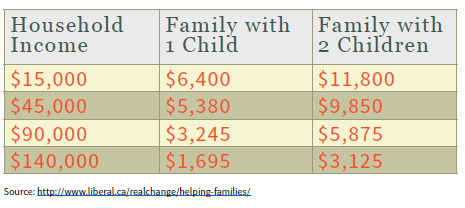The family benefits include more money given directly to most parents, and these benefits extend to those earning $200,000.1
All of the existing benefits are streamlined into one, which is an advantage for the sake of simplicity. In addition, these benefits target those with lower incomes. The benefits are not taxed.
The greater flexibility afforded by extending parental leave time to 12 months within an 18 month period is another positive improvement in the government's family package.
The Liberal government's new Canada Child Benefit combined with increased flexibility on parental leave is a help to families because it returns more tax dollars directly to Canadian families. The plan is focused on cash benefits as contrasted with the creation of a government daycare system.
However, it's not all sunny days. On a note of caution it remains unclear whether or not the Liberals will attempt both cash benefits to families and national daycare.
The withdrawal of income splitting, also known as family taxation, is another negative change. Family taxation allows families to file their taxes as they are already doing their family budget: together.
A consequence of the government's actions on child benefits combined with the removal of family taxation is that the emphasis shifts toward poverty reduction and away from a recognition of children or the family as important societal institutions.
The Liberal government package helps families in the short term by giving money directly to them and creating greater flexibility in parental leave; however, the long-term method of delivery raises concerns about how the family unit will be recognized and supported.
In sum, we give the new child benefits a "B". This grade recognizes the positive contributions, while indicating there remains room for improvement.
What is the Liberal Plan for Families?
The Canada Child Benefit will replace today's numerous family benefits.
These benefits included the Universal Child Care Benefit (UCCB), the Canada Child Tax Benefit (CCTB), the National Child Benefit Supplement (NCBS), and a limited form of income splitting.
To help pay for the new benefits, the new Liberal plan promises to cancel family taxation, also known as income splitting. (Note: They are committed to keeping pension splitting for seniors).
According to Liberal calculations, the new Canada Child Benefit can be broken down as follows:
This would provide greater benefits to families earning more than $140,000, contrary to popular perceptions during the election campaign.2
According to economist Kevin Milligan of University of British Columbia, "[T]he base benefit is $5400 per year for each child, with a bonus of $1000 for children under age six."
As with the Canada Child Tax Benefit and the National Child Benefit Supplement, the benefit is slowly phased out as an individual earns more income. Professor Milligan points out the net result "is a benefit that is far larger than the existing package for most people under $150,000 of income."
Such streamlining of benefits and returning of tax dollars directly to parents are positive. These changes are not giving tax dollars to institutions that parents may or may not be able to use, which is the fundamental premise of a national daycare program.
Instead, giving money directly to parents does a few important things. First, it respects family diversity—the reality is that every family is different and will likely choose to use that money differently. Secondly, giving families tax dollars back without telling them how to spend the money signals that the family is respected as an institution. Putting money into a one-size-fits-all daycare system takes the diversity of Canadian families and offers only one solution. It would also fail to respect the autonomy of families since national daycare would be something for which Canadian families would pay whether they would choose to use it or not. And we have evidence that this is not Canadians' first choice for childcare; therefore, avoiding this system is important—the high amounts of money required to make such a system work can be spent vastly better ways.
Parental Leave Flexibility
Another element of the government's plan is the expansion of the time allotted to parental leave. This has been discussed little—the basics of the plan that are publicly available include increasing access to benefits for 18 months, instead of 12. As per media reports, "workers would be able to take time off, return to work, and take more time off within that 18-month period."

Why does this matter? Such a change sensitizes us to the reality that once a baby arrives, care does not stop at one year. Right now, many mothers (and some fathers) enjoy one year off, resulting in an abrupt and total re-entry into full-time work when that is over. When parental leave is over, there are few special accommodations for the needs of working parents. We should be angling for recognition of the power and importance of parenting by acknowledging the responsibilities parents have well past one year.
At the same time, we should also allow parents at home receiving benefits to do some work. A clawback of benefits at the first hour or two of work makes for an all-or-nothing approach that is not beneficial for parents or employers. Parents, even in the early days of a new child, may either need or desire some work outside the home as it allows for skills to remain fresh and the earning of a little extra money. Employers could benefit from this as well. For starters, it ensures that everyone remembers the person on leave, and it may also ensure the person's place is still available upon their return so that employers do not need to find replacement staff.
It should also be noted that the government should not be solely responsible for these changes. Businesses will want to show that they can accommodate parents in an attempt to attract and retain good workers regardless of family circumstance. Canada does not have a replacement fertility rate, and immigration, as important as this is, does not accommodate all of our work needs. Employers are going to need to figure out ways to keep a talented workforce, and good parental benefits—including but not limited to flexible parental leave—are going to be part of that.
The Point of Social Programs
Analysts point out that social benefits for families and children try to find a balance between two priorities: poverty reduction and parental recognition.
To this we can add political expediency. For example, the purpose of the Universal Child Care Benefit, first introduced in 2006 at $100 per month, was neither poverty reduction nor parental recognition.
In that election cycle, the UCCB thwarted the institution of a national daycare, another perennial policy idea that is targeted at neither poverty reduction nor parental recognition. By way of example, the UCCB marked the use of a political lever to avoid a larger policy boondoggle.
Why is national daycare a policy boondoggle? While a national daycare program appears attractive on the surface, offering one low cost choice, it has the unintended consequence of reducing choice for parents. Take the example of Quebec where other family benefits were cut in order to accommodate the new provincial plan, leaving many families in worse shape than before.3 In discussing Quebec's low cost provincial daycare plan, many scholars agree that it does not offer greater choice: "Although the new policies promote work, they inadvertently limit women's choices by offering more assistance to families with employed mothers than to families with stay-at-home mothers (through universal $5-a-day day care and through cutbacks in social assistance)."4
The unintended consequences of offering a program at a subsidized cost creates false demand, and, subsequently, waiting lists that land parents who are already stressed for lack of care in exactly the same place as before the subsidized program came into existence.
Indeed, all government plans need to be balanced with possible unintended consequences. Alexandre Laurin, author of The High Cost of Getting Ahead: How Effective Tax Rates Affect Work Decisions by Lower-Income Families describes some of these in the realm of family benefits.
According to Laurin, a real risk is that as individual earns more, benefits are withdrawn. This withdrawal acts as a hidden tax. For many secondary earners, the withdrawal of benefits due to working more and earning more money might not pay off.
Laurin gives the example of a hypothetical married couple, Jennifer and Jeffrey, with two young children. Both parents have paid jobs. As Jennifer considers working more, she may find that she keeps only 30 cents per extra dollar of earning. Seventy percent would be clawed back as benefits are withdrawn in what is known as the Marginal Effective Tax Rate (METR).
This effect, as Laurin measures it, is worse in Quebec where working more might result in an 80 percent clawback, and slightly better in the western provinces, where the "METR would peak at around 60 percent."
The point is that individuals who could be contributing more to the economy may choose not to, based on a benefit structure that incentivizes less work and lower take home income.
Individual Benefits Versus Family Benefits
With the withdrawal of the current income splitting plan Canadian families are losing an important opportunity.
Income splitting allows parents to file taxes together. The higher earning in a marriage can "share" income with lower earner, thereby decreasing the tax burden. In so doing, income splitting assigns a value to the family as a group and to the benefits that working together brings.
Income splitting, offered in other countries including Germany, France, the Czech Republic, and the United States, prioritizes family as the building block of society and provides for horizontal equity. "Horizontal equity" is another way of saying that families who earn the same amount should be taxed the same regardless of how that money comes in—from two earners or one. (And it is worth noting that in France, a single parent can share income with a child.)

Horizontal equity is the primary purpose of income splitting. And this tax measure would have resulted in a tax cut for almost half of all families, that according to the policy's detractors.
Income splitting is good in theory, but tricky to get right in practice. The limitations the Conservatives placed on income splitting were large; couples would be able to share only $50,000 to a maximum benefit of $2000. The end result of this limitation was that the main principle of income splitting, that of correcting horizontal inequity, was not met.
Still, choosing to do away with income splitting completely is a blow to families. William Gairdner, author of The War Against the Family, recently discussed on a radio program how Sweden's move toward cradle-to-grave social benefits began with the cancellation of income splitting for families, in favour of the taxation of individuals.
Gairdner explains how the architects of the Swedish welfare state needed to get more workers into the economy to support the high cost of welfare benefits. The first step was the removal of income splitting, thereby ensuring that more people—at that time, largely mothers—entered the workforce as taxpayers. (That Sweden's experiment did not go well is evident, and many aspects of their welfare state and correspondingly high tax burden have been repealed.)
Critics of income splitting have long argued that it is social engineering or coercive. However, most tax policy has social implications; even the removal of a tax can be meant to influence behaviour as was the case in Sweden when the removal of family taxation was used to encourage both parents to work outside the home.
Additional Items to Watch
While the NDP ran on a platform of $15-a-day daycare, the Liberals did not. Today, the government is saying instead it will examine a "National Early Learning and Child Care Framework, to deliver affordable, high-quality, flexible and fully inclusive child care."
It remains to be seen what this framework means. Two things are heartening for those who do not want national daycare. The first is that federal politics is not where the action is on daycare these days. The provinces have been active on this file lately in different ways, making it more difficult to bring them to a federal agreement. The second is that any national daycare framework, however minimal, would put the Canadian government many more billions of dollars into deficit and debt.
Conclusion
- The new package of benefits returns tax dollars to many families earning below $150,000 and achieves certain poverty reduction goals. It also appears to help some above the $150,000 mark with children under six in particular. All this said, with the increased flexibility in parental leave, it is a decent package for many Canadian families. Giving tax dollars to parents is far and away preferable when contrasted with other options, for example, the creation of a national daycare system.
- While it seems unlikely the Liberals will be able to adopt a national daycare system in the current economic climate, this is something to watch carefully. A national daycare program at the expense of support for parents reduces choice and impairs a healthy social architecture.
- Finally, poverty reduction is admirable, but it is not the same thing as family policy. Family income splitting, also known as family taxation, was a genuinely family-friendly policy, which, done properly would have provided for horizontal equity as well as a tax cut for Canadian families with children.
- Policy makers need to be reminded that parents taking care of children are working and providing a service to their families and communities that may not be easily measured but is nonetheless real. Incentives to push parents of young children into the workforce when they do not want to be there is not good policy. Policies that claw back all benefits when new parents might want to work part-time whilst maintaining benefits are likewise not good policies.
- Good family policy maximizes the choices available to parents to care for their children and increasingly for their elderly parents, as well.
- We give this family benefit package the grade of a "B". It is a solid effort, yet there is also room to improve.
Notes
1 While this contradicts Liberal campaign literature, a Liberal online calculator shows benefits up to approximately the $200,000 level of income. Employment and Social Development Canada did not respond to numerous requests for clarity. Retrieved online at
https://www.liberal.ca/realchange/canada-child-benefit-plan/?shownew=1
2 A
shows a family earning $200,000 with two children under six receiving $825 annually. In another example, a family earning $200,000 with four children under six, is allocated $9200 annually, tax-free. Three children under six at the same income level receive $2800.
3 "But even the new family assistance policies have shortcomings. A recent study indicates that 72 percent of Quebec families are worse off under the new family assistance program than under the earlier pro-natal one, despite government promises that 95 percent of families would benefit from the new policies." Retrieved from
http://www.prb.org/Publications/Articles/2001/QuebecsAlternativetoPronatalism.aspx
4 Ibid.


